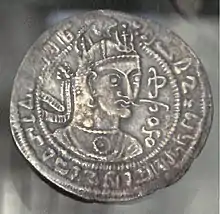Tegin
Tegin (Old Turkic: 𐱅𐰃𐰏𐰤, romanized: Tegin, also tigin, MC *dək-gɨn > Pinyin: Tèqín; Chinese: 特勤, erroneously Tèlè 特勒[2][3]) is a Turkic title, commonly attachable to the names of the junior members of the Khagan's family.[4][5][6] However, Ligeti cast doubts on the Turkic provenance by pointing to the non-Turkic plural form tegit[7]

History
History records many people carrying the title Tegin. The best known is Kül Tigin (闕特勤; Queteqin, erroneously 闕特勒; Quētèlè[8]), noted for the stele in his memory in the Orkhon inscriptions. Some Tegins founded and headed their own states. Alp-Tegin, founder of the Ghazni state, which grew into the Ghaznavid Empire; Arslan Tegin and Bughra Tegin, both instrumental in the creation of the Kara-Khanid Kaganate. The Chinese History of the Northern Dynasties states that the Hephthalite emperor of the Gandhara state was from a ruling clan of the neighboring Tegin state. [9] With time, the title tegin became a popular personal name, and now perseveres both as personal and family name, predominantly in the South Asia and Middle East areas.
Notable Tigins
References
- Ancient Coin Collecting VI: Non-Classical Cultures, by Wayne G. Sayles p.81
- Sanping Chen, "Son of Heaven and Son of God: Interactions among Ancient Asiatic Cultures regarding Sacral Kingship and Theophoric Names", Journal of the Royal Asiatic Society, Third Series, Vol. 12, No. 3 (Nov., 2002), p. 296: Writing 勒 instead of 勤 is a common script error in current editions of almost all dynastic histories
- Maue, Dieter. "The Khüis Tolgoi inscription - signs and sounds". Academia.edu. Retrieved 4 November 2018. p. 13-14
- Jiu Tangshu vol 194 upper "可汗者,猶古之單于;[...] 其子弟謂之特[勤] (ms. 特勒)" Tr. "the Kehan, in the past, was called Chanyu: [...] His sons and younger brothers are called Te[qin] (ms. Tele)"(in Chinese)
- Xin Tangshu Vol. 215 upper (in Chinese) "至吐門,遂強大,更號可汗,猶單於也,[..] 子弟曰特[勤] (ms. 特勒)" tr. "Till Tumen, [who] has achieved strength and greatness and is now called Kehan, formerly Chanyu, [...] [his] sons and younger brothers are called Te[qin] (ms. Tele)
- Taskin V.S. "Materials on history of Dunhu group nomadic tribes", Moscow, 1984, p. 432
- Ligeti, L (1975), Kiadó, A (ed.), Researches in Altaic languages, University of Michigan, p. 48
- Sanping Chen, "Son of Heaven and Son of God: Interactions among Ancient Asiatic Cultures regarding Sacral Kingship and Theophoric Names", Journal of the Royal Asiatic Society, Third Series, Vol. 12, No. 3 (Nov., 2002), p. 296, note on misspelling
- Zuev Yu.A. "The strongest tribe Esgil" //Materials of International Round Table, Almaty, 2004, p.44, ISBN 9965-699-14-3
.svg.png.webp)